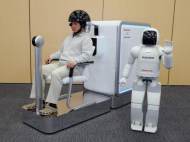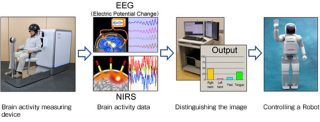Honda’s “Brain Machine Interface”
 Honda Research Institute Japan Co., Ltd. (HRI-JP), Advanced Telecommunications Research Institute International (ATR) and Shimadzu Corporation have collaboratively developed the Brain Machine Interface (BMI) technology that uses electroencephalography (EEG) and near-infrared spectroscopy (NIRS) along with newly developed information extraction technology to enable control of a robot by human thought alone.
Honda Research Institute Japan Co., Ltd. (HRI-JP), Advanced Telecommunications Research Institute International (ATR) and Shimadzu Corporation have collaboratively developed the Brain Machine Interface (BMI) technology that uses electroencephalography (EEG) and near-infrared spectroscopy (NIRS) along with newly developed information extraction technology to enable control of a robot by human thought alone.
It does not require any physical movement such as pressing buttons. This technology will be further developed for the application to human-friendly products in the future by integrating it with intelligent technologies and/or robotic technologies. To control the robot, the person wearing the helmet only had to think about making the movement. Its inventors hope that one day the mind-control technology will allow people to do things like turn air conditioning on or off and open their car boot without putting their shopping down.
The helmet is the first “brain-machine interface” to combine two different techniques for picking up activity in the brain. During the human thought process, slight electrical current and blood flow change occur in the brain. The most important factor in the development of the BMI technology is the accuracy of measuring and analyzing these changes. The newly developed BMI technology uses EEG, which measures changes in electrical potential on the scalp, and NIRS, which measures changes in cerebral blood flow, with a newly developed information extraction technology which enables statistical processing of the complex information from these two types of sensors. As a result, it became possible to distinguish brain activities with high precision without any physical motion, but just human thought alone.
The BMI technology announced by HRI-JP and ATR in 2006 used a functional magnetic resonance imaging (fMRI) scanner to measure brain activities. The large size and powerful magnetic field generated by the fMRI scanner limited the locations and conditions where it can be used. As the newly developed measuring device uses EEG and NIRS sensors, it can be transported to and used in various locations. Brain activity picked up by the helmet is sent to a computer, which uses software to work out which movement the person is thinking about. It then sends a signal to the robot commanding it to perform the move. Typically, it takes a few seconds for the thought to be turned into a robotic action.
In the experiment, the human, wearing the helmet, is shown a card with a symbol of a hand raised. The human then imagines the act of raising his hand. The Asimo robot then announces that he received the instruction and raises his hand. The demonstration was video-taped because, according to Honda, the human subject could have been too distracted in front of a live audience. They claim the robot achieved 90% accuracy during testing.
Honda said the technology was not ready for general use because of potential distractions in the person’s thinking. Another problem is that brain patterns differ greatly between individuals, and so for the technology to work brain activity must first be analyzed for up to three hours. Yet another problem is the need for miniaturization in order to make the helmet wearable on the move.










Leave your response!